RightBattery.com
Tests and reviews of different batteries to help you find the Right One…
Search
Posts Tagged ‘power bank capacity’
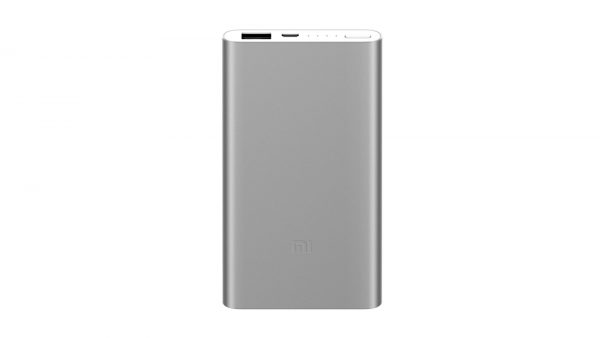
Power banks are quite useful gadgets nowadays with so many battery powered devices we use in our everyday life, not only our smartphone or tabled, but a number of other gadgets like a smartwatch, hands-free, wireless headphones and many more. When all of these cool and useful battery powered gadgets do come with a rechargeable Lithium battery and can be charged over USB you need a power bank with you to be on the safe side when you are in need of some extra power and are on the move. Carrying a USB charged is also a good idea, however you not always have access to a power outlet, especially when you are traveling around or even just on the move to go somewhere like school or work. Getting the right power bank for your specific needs however can be a bit challenging and power bank manufacturers usually do not help you that much to ease your choice. There are already a lot, really a lot of brands with different forms and shapes, capacities and features you can find available and with a different price range, so how to choose he right power bank and what to look for? We are going to try to help not only with our tests of various power banks, but also with some tips to have in mind when choosing a power bank…
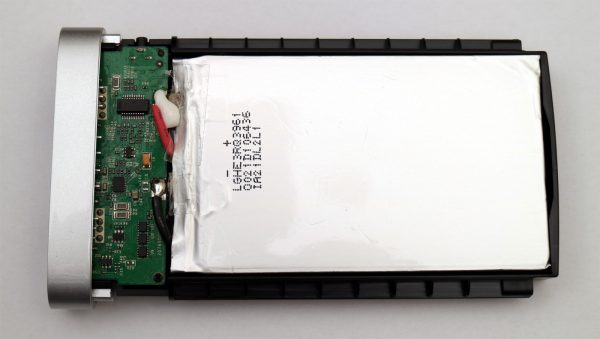
Capacity
The capacity of a power bank is usually the fits thing people look for, the higher – the better, however there is a catch here and you need to know a few things. First and most important one is that the capacity stated for a power bank is not the actual capacity you can get out of the device, the capacity on the package is the capacity of the battery that is used inside the power bank. The actual usable capacity that comes out from the output USB port for charging devices is usually in the range of about 60-70% and there is a really simple reason for that.
Power banks use Lithium-based rechargeable batteries that are rated at 3.6V-3.7V (when fully charged they reach 4.1V-4.2V), but the device needs to output 5V to charge USB devices. In order to have 5V output you need a step-up voltage converter that increases the input voltage to the desired value, however during this power conversion there is loss. The efficiency of conversion is better in the beginning when the Lithium battery is fully charged with lets say 4.2V, but as it gets discharged the voltage drops and the efficiency gets worse.
Here is an example with a power bank that is being advertised as 10000 mAh capacity, the maximum actual output from the USB port for charging devices will very likely be somewhere in between 6500 and 7500 mAh when you take into account the efficiency of the power conversion into account.
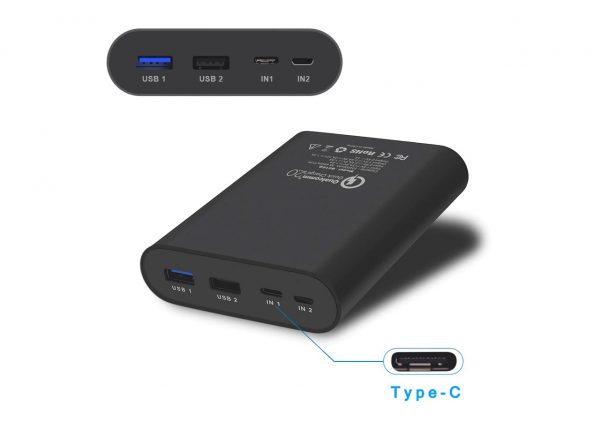
Time to Charge the Power Bank
You need to read the specifications of a power bank carefully and pay attention not only to the capacity, but also to what is the input voltage and current that is needed to charge the power bank itself. The input voltage is normally 5V, so that you can easily use a standard USB charger to charge the power bank, however the more important number is the input current in Amps. Smaller power banks do come with 1.0A input current and larger capacity normally come with 2.0A input current as this is pretty this is standard for power banks that use mini or micro USB ports for charing the internal battery. There are some higher capacity models that come wit USB type-C connectors for charging the power bank and these can actually have support for higher input voltage and curent. But why are these numbers actually important? Well, the input voltage and current are crucial to the time it takes for your power bank to get charged after you use it to charge other devices and it needs recharging.
If we have a 10000 mAh capacity power bank that has 5V and 1.0A input, then it would mean that that time needed for a full charge of the battery inside the power bank could as well be around 10 hours or even a bit more. That also depends on the source of power you are using to charge the power bank as power banks are normally being sold without charges and only a USB cable by default. If the input voltage is 5V and the current is 2.0A the charge time will be cut in half, so around 5 hours for a full charge of the same 10 Ah battery.
If you use the USB 2.0 port of your laptop for example to charge a power bank the time needed for a full charge may be even longer with the standard 0.5A output for these and for USB 3.0 the standard maximum output current is 0.9A, so a bit better. It is recommended to use an external charger with higher current output if your power bank supports it and you should look for higher capacity models that do support higher input currents and maybe even voltages as well in order to have the power bank charge itself faster.
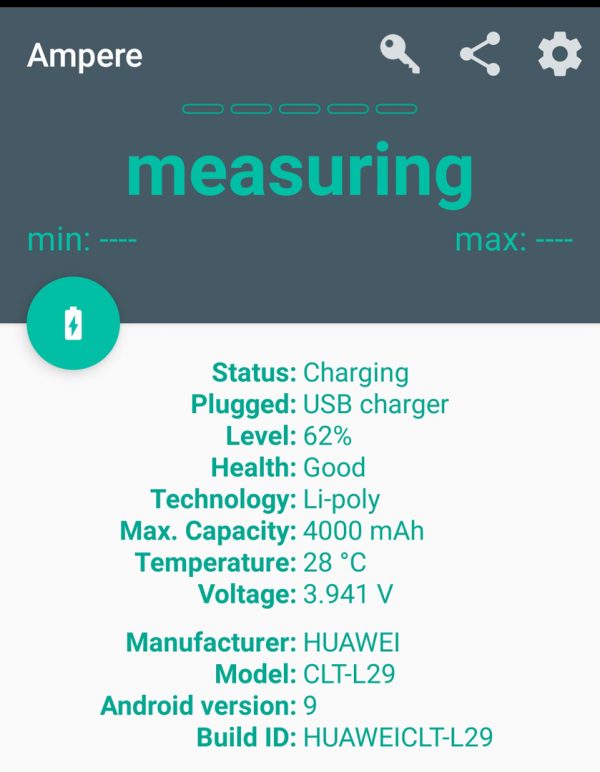
Time to Charge a Device
The output voltage and current specifications are as important as the input ones as they relate to how quickly you will be able to charge your smartphone especially as with most other devices things are not that important. The latest generation of smartphones come with big screens and larger batteries and they implement new faster charging technologies in order to ensure that the device can be recharged faster when plugged in. Most power banks, especially the more affordable models do not yet support faster charging technologies, so you are normally limited to 1.0A or 2.0A/2.1A maximum. If the primary use of the power bank is to charge your smartphone and it supports any of the fast charging technologies you may look for a power bank that supports higher output voltages and currents to match the smartphone. There are a few technologies like that available, so make sure to match the one of the smartphone with the power bank.
In order to get a better idea on how fast is your smartphone or tablet charging you can use a helpful software application for Android such as Ampere for example available for free from Google’s Play store. It will give you a real time information about the battery type, capacity, voltage and charging current and other information. This is important to know as sometimes you may just think that your smartphone is charging with higher current than it actually is due to some incompatibility with a specific power bank resulting in improper detection of the supported charging parameters.
3250 mAh Xiaomi Mi Power Bank Flashlight Test
4, Mar 2019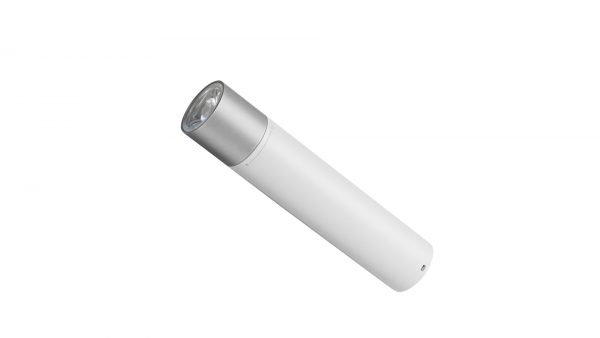
One interesting compact power bank that doubles as a useful flashlight from Xiaomi that can be turn out to be quite useful gadget to keep in your car or bag wen you travel. The 3250 mAh Xiaomi Mi Power Bank Flashlight does not come with that big charging capacity, but you can also use the device as a flashlight with a 3W LED that has 11 levels of adjustable brightness and an SOS signal function. This power bank comes in a good looking compact aluminum body and an easy to use flashlight function that can be activated by turning the front of the device around. Specifications wise with the small capacity battery and the 5V/1A input and output you should to expect too much from it, though it can really be helpful in emergency situations to save the battery of your smartphone or actually to save you in case of real emergency where you can use the flash light functionality.
3250 mAh Xiaomi Mi Power Bank Flashlight Specifications:
– Battery capacity: 3250mAh, 3.63V, 11.8Wh (Li-Ion 18650)
– Input Voltage: DC 5.0V
– Output Voltage: DC 5.0V
– Input current: 1.0A
– Output current: 1.0A
– LED light: 3W LED, 11 levels of brightness, SOS function
– Size: 12.02 x 2.55 x 2.55 cm / 4.73 x 1 x 1 inches
– Weight: 104g
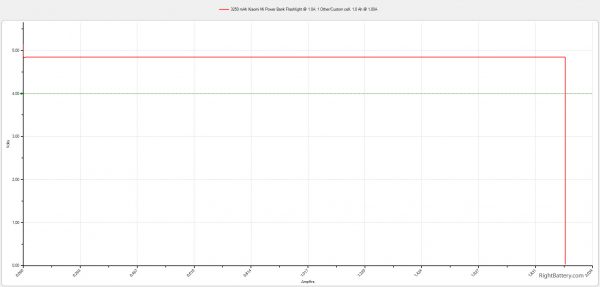
Since the 3250 mAh Xiaomi Mi Power Bank Flashlight is rated at 5V/1A output we have tested the battery at constant current load of 1A and the performance we get is quite good. The discharge curve looks great – stable at 4.85V voltage across the board and with close to 2000 mAh usable capacity. These little gadget is quite handy, though do to expect to have a full charge of the battery of your recent smartphone that may actually have a battery with twice that capacity, still it can help when you are in a pinch. And to tell you the truth we actually fell in love with the combination between power bank and flashlight in terms of functionality and the design and build quality of this device.
The performance of the 3250 mAh Xiaomi Mi Power Bank Flashlight in our tests:
– 1937 mAh at 1.0A load
– 9.381 Wh at 1.0A load
5000 mAh Xiaomi Mi Power Bank 2 (PLM10ZM) Test
28, Feb 2019
The Xiaomi Mi power banks are a popular affordable and good looking choice for mobile USB power banks, so much that they even get their own knockoffs with cheaper built and looking and worse performing variants from other Chinese companies. Here we have an earlier version of the Mi Power Bank 2 model number PLM10ZM that is a bit thicker than the latest version, but other than that should be very similar in performance and features like the newer thinner version that we are soon also reviewing here. With this model Xiaomi has managed to provide you with a decent capacity of 5000 mAh in a slim and lightweight package with great looks and an attractive price. Slim yet sturdy aluminum case with a number of safety features built into the electronics as well as power check button with LED indicator lights and USB charging connector with 2A input for faster charging time and USB port with output current of maximum 2.1A.
5000 mAh Xiaomi Mi Power Bank 2 (PLM10ZM) Specifications:
– Battery type: Lithium-ion Polymer rechargeable cell
– Input Voltage: DC 5.0V
– Output Voltage: DC 5.1V
– Input current: 2000mA (TYP)
– Output current: 2100mA (TYP)
– Rated capacity: 3.7V / 5000 mAh / 18.5 Wh (TYP)
– Charging time: 3.5 hrs with 5V/2A plug and standard cable
– Size: 127 * 68.9 * 10.7mm
– Load detection: Auto-detects device plug-in/plug-out
– Safety: Supports protection from over-voltage (input and output), over-current (input and output), short circuit, over-charge, over-discharge, and battery Positive Temperature Coefficient (PTC)
– Out of power protection: Awake once plugged to the charger
– Charging temperature: 0C-45C (TYP)
– Discharging temperature: Initial -20C~+60C (TYP)
– Weight: 156g

With the 5000 mAh Xiaomi Mi Power Bank 2 (PLM10ZM) we have performed our usual 1.0A and 2.0A constant current load tests and you can see the results on the discharge graph above. At 1.0A discharge load we get a stable output voltage of about 4.93V and a little over 3300 mAh usable capacity and this is quite good and confirms the minimum 3300 mAh actual output claimed by Xiaomi for this product. At the higher 2.0A constant current discharge however things do not look as good for this power bank, because not only the output voltage is lower, but it also fluctuates a lot as you can see between 4.5V and 4.68V resulting in significantly lower Wh output for the battery at higher load. Hopefully this has been addressed in the newer slimmer version of the power bank and this is something we are hoping to confirm soon as we kind of expected better performance at 2A loads.
The performance of the 5000 mAh Xiaomi Mi Power Bank 2 (PLM10ZM) in our tests:
– 3306 mAh at 1.0A load
– 2921 mAh at 2.0A load
– 16.30 Wh at 1.0A load
– 13.50 Wh at 2.0A load